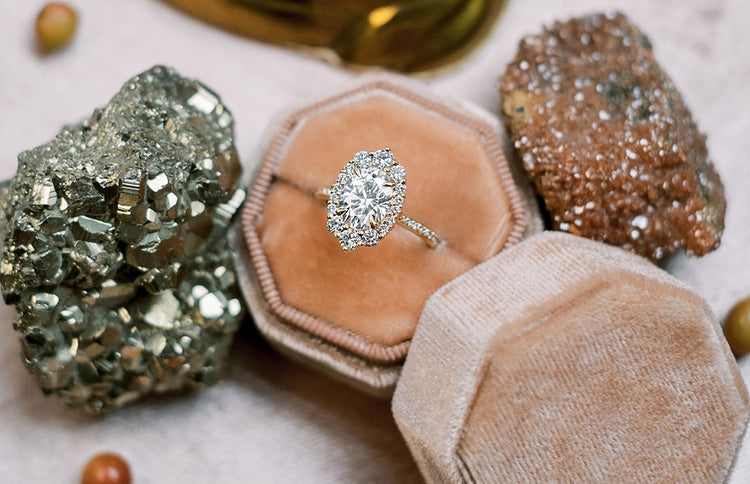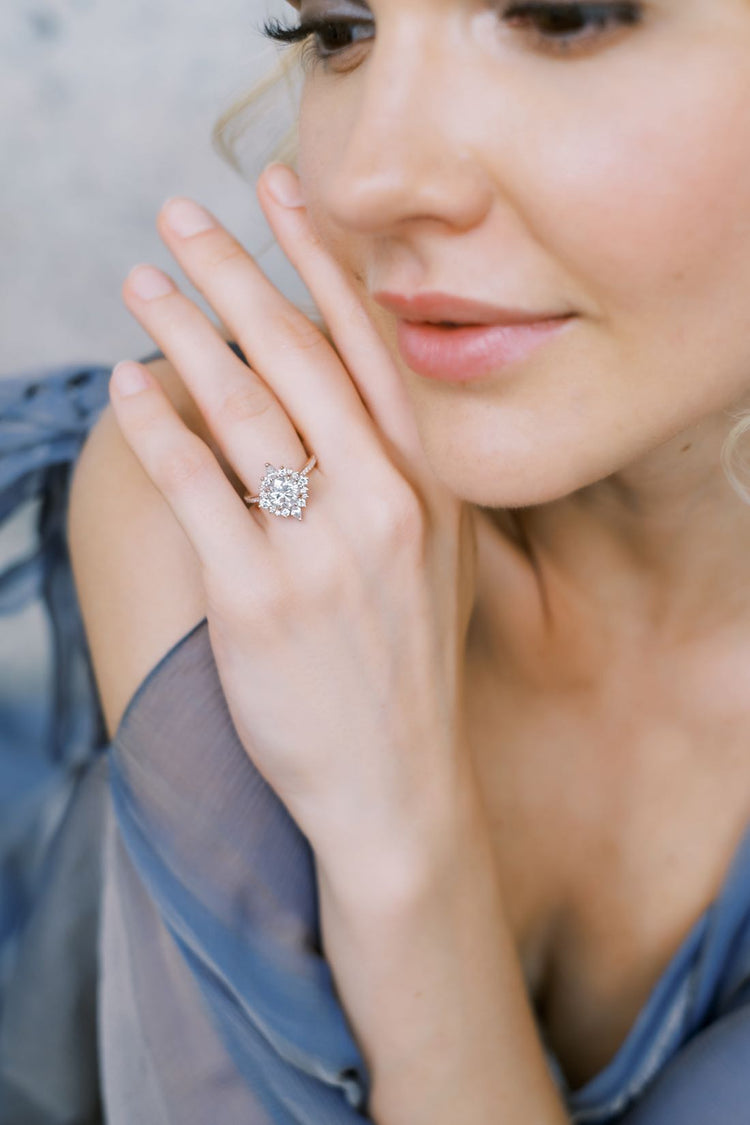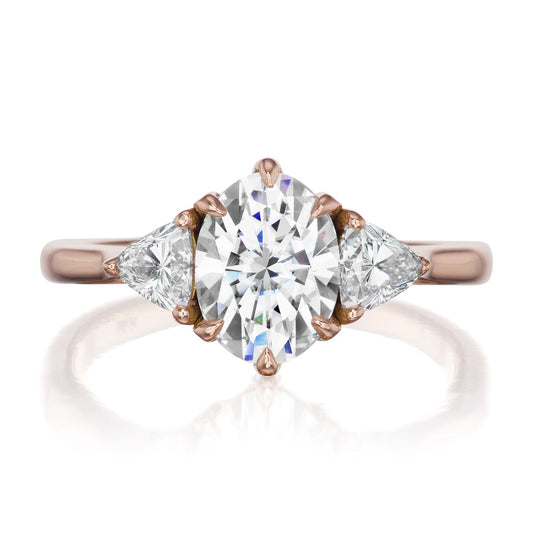LEARN ABOUT MOISSANITE
An Eco-friendly, Affordable Engagement Ring Alternative
Learn how moissanite compares to diamond in terms of its chemical and optical properties, as well as its durability, pricing, and maintenance. This is a must-read for anyone considering moissanite.


Conflict-free

Sparkling
Durable

Affordable
WHAT IS MOISSANITE?
Discovered from the Stars
Moissanite was first discovered in 1893 by a Nobel-Prize winning French scientist, named Henri Moissan. He discovered the mineral on a meteor that struck earth, leaving the moissanite particles in its crater. At first, Moissan thought he had discovered diamonds from outer space, but then realized that the crystals were a silicon carbide chemical composition, rather than the pure carbon composition of diamond.
How It's Grown: Henri Moissan spent the rest of his life trying to recreate the crystal, but never succeeded. It wasn’t until a century later in the 1990’s that scientists in North Carolina invented the process to successfully grow the mineral in a lab. All moissanite on the market today is grown in a laboratory using these highly technological equipment and processes, since not enough of it occurs naturally on our planet.

Moissanite vs. Diamond
Comparison Guide:
Is moissanite a diamond? Though it has a similar appearance to diamond, moissanite is an entirely different mineral with its own inherent properties.
Moissanite:

Brilliance & Fire: Moissanite has a higher Refractive Index of 2.65 – 2.69, resulting in more brilliance. It also has better fire dispersion than diamond, creating sparkle that exhibits rainbow-like flashes of color.
Durability: Moissanite ranks at 9.25 on the Mohs Scale of Hardness, making them well-suited for everyday wear.
Color: Moissanite is available in near-colorless or colorless range options.
Diamond:

Brilliance & Fire: Diamond has a slightly lower refractive index of 2.42. It also has lesser fire, resulting in whiter sparkle that exhibits fewer rainbow-like flashes of color.
Durability: Diamond is the hardest material on earth, ranking at 10 on the Mohs Scale of Hardness, which is why it's a popular engagement ring choice.
Color: White diamonds range from lightly colored to colorless, and are priced accordingly.
ETHICAL & SUSTAINABLE
A More Eco-Conscious Alternative
Because it’s created in a lab, moissanite avoids the problematic issues tied to gemstone mining, and the devastating effects that mining has on our environment and its inhabitants. Moissanite has a smaller carbon footprint than mined gemstones or diamonds, making it a more sustainable and responsible choice.

HOW IS MOISSANITE GRADED & SOLD?
By Color Ranges:
Unlike diamonds which are graded according to the 4 C’s of carat, clarity, color, and cut, moissanite is only sold by color ranges. You can purchase a colorless moissanite that would grade in the D-F range, or a near-colorless moissanite that would grade in the G-I range. We only sell moissanites with eye-clean clarity, meaning there are no inclusions visible to the naked eye. Moissanite gems do inherently have tiny needle-like inclusions visible under 5-10x that occur naturally during the crystal-growing process. These inclusions do not affect its overall brilliance, and can’t be spotted with the naked eye.
HOW IS MOISSANITE GRADED & SOLD?
By Diamond Equivalent Weight:
Instead of being sold by carat weight, moissanite is actually sold by millimeter size and its “diamond equivalent weight” or DEW. The reason it’s not sold by carat weight is because it has a different density and specific gravity than diamond. That means that a moissanite will weigh about 12% less than diamond of identical dimensions. For example, a round diamond that measures 6.5mm in diameter might weight 1ct. Whereas a moissanite that’s 6.5mm in diameter will only weigh around .88ct. Since people are accustomed to diamonds of a certain diameter being a certain carat weight, moissanites are sold by their diamond equivalent weight rather than their actual weight. For example, a 6.5mm round moissanite has a 1ct diamond equivalent weight, but will just be called 1ct.

HOW IS MOISSANITE GRADED & SOLD?
Brands We Carry:
We are proud to offer only the finest brands of moissanite. For white moissanite, we offer stones from Charles & Colvard,
who were the originators of moissanite, as well as from Supernova. Learn more about how these brands compare here. For colored moissanite, we offer our exclusive line of Iconic moissanite, featuring rare colors in the finest cuts.
IDENTIFIYING MOISSANITE
How is Moissanite Distinguished from Diamond?
Moissanite has a very similar look to diamond, and can often be tough to spot to the untrained eye. Not only does moissanite look visually similar to diamond, but it even tests as diamond using traditional diamond testers. Other methods often have to be used to determine if a stone is moissanite:
1. Use a special moissanite/diamond testing device that can distinguish these stones from each other.
2. Use a jeweler’s loupe to look for those needle-like inclusions that are unique to moissanite
3. Moissanite has a distinct “double refraction” or doubling effect of the facet junctures that can be viewed under magnification.
4. Moissanite’s specific gravity can be tested using special devices
5. Moissanite conducts heat and electricity differently than diamond, and its conductivity can be tested using specialized equipment.

DURABILITY
Second Hardest Gem on Earth
Moissanite is the second hardest material on earth, ranking at 9.25 on the Mohs scale of hardness, making it even harder than white sapphire or ruby. Moissanite’s durability is second only to diamond, which ranks at 10 and is the hardest material on earth. Moissanite’s toughness makes it a great option for an everyday ring meant to be worn for years.

MAINTENANCE
Caring for & Cleaning Your Moissanite
Unlike many other white gemstones, such as white moissanite or white topaz, moissanite’s superior optical properties mean that it can sparkle even when it’s not perfectly clean. This is a major bonus, since it doesn’t need the extremely frequent cleaning that white sapphire requires. Unlike white sapphire that is more see-through and appears milky and opaque as it gets dirty, moissanite maintains its brilliance better since it’s much better at reflecting light back up to the eye even when not perfectly clean.
But as with all gems and diamonds, moissanite should still be cleaned and cared for according to the Care & Cleaning guide. It can also attract oils to its surface (moreso than diamond), so it’s best to keep your stone clean to avoid buildup that can become harder to remove if you neglect to clean it periodically.

MOISSANITE VS. DIAMOND COMPARISON
Which One to Choose?
Love the idea of a more sustainable and affordable stone, but want your ring to be even more durable and less maintenance? We’d recommend lab-grown diamond, which is chemically, optically, and physically identical to mined diamond, but with a much lower environmental and monetary cost. Learn all that’s to love about lab-grown diamonds.






